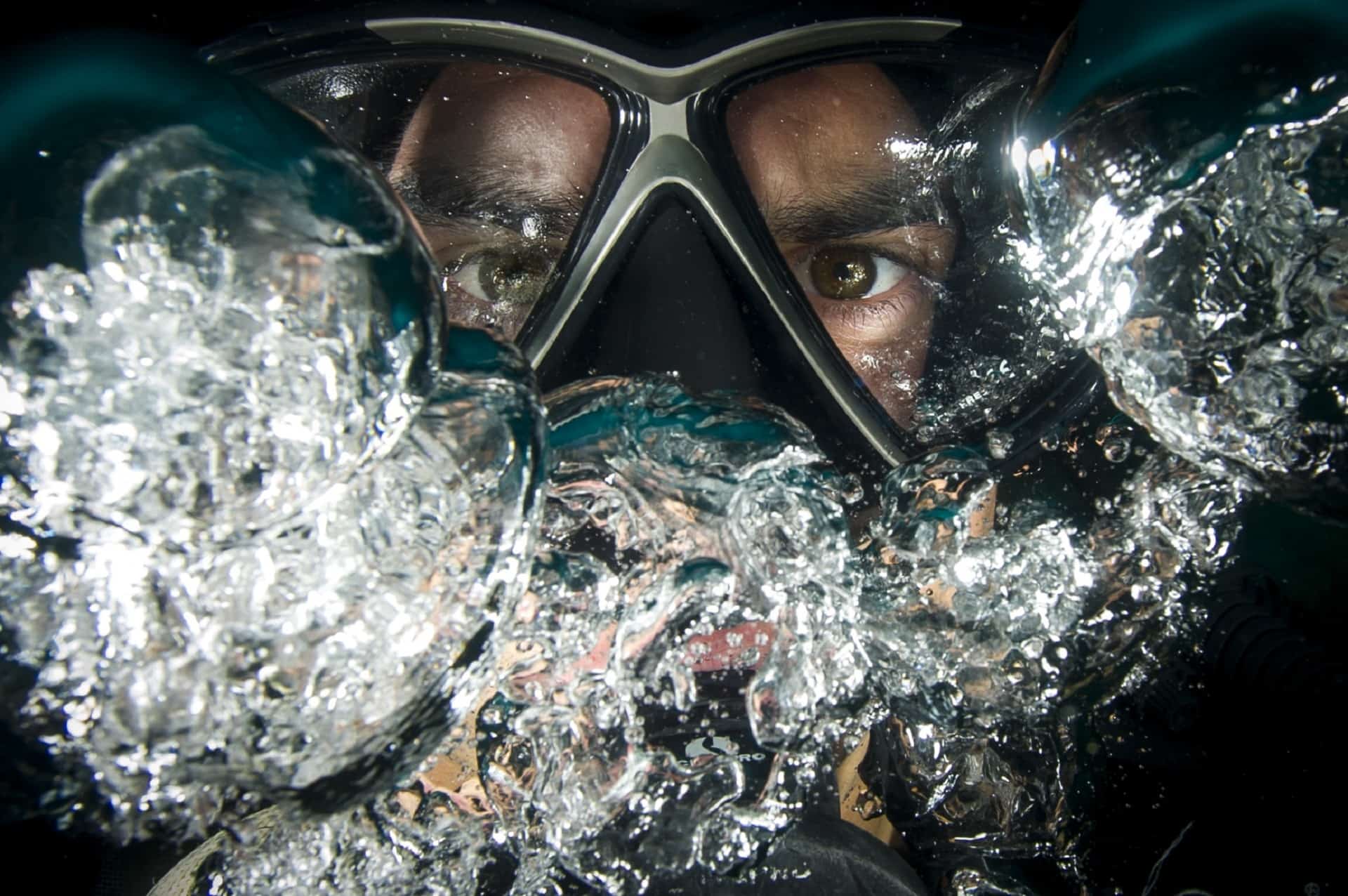Dive Site #1: Apo Island, Negros Oriental
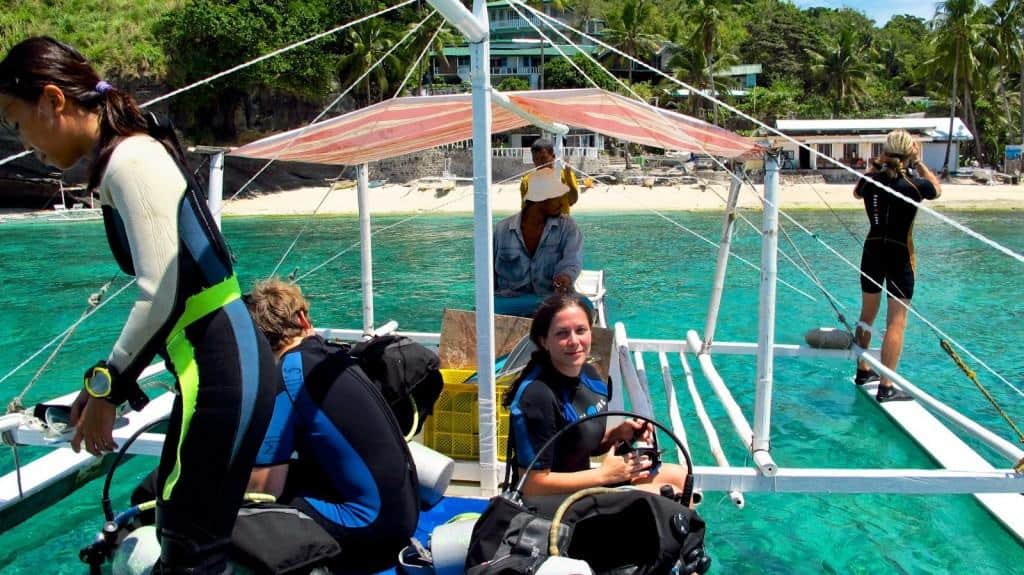
Apo Island is a 12 hectares of volcanic island surrounded by beautiful coral reefs. The waters surrounding it form a protected marine reserve with over 650 species of fish and 400 species of corals, including Brain Corals, Gorgonian Sea Fans, and Bubble Corals. This marine sanctuary, one of the most prominent in the world, is the inspiration for the Wild Reef Exhibit at the Shedd Aquarium in Chicago. It’s no surprise that Apo Island is one of the top scuba diving destinations in the Philippines!
Some of the most popular scuba dive sites around Apo Island are:
- Largahan: a shallow, sandy slope that’s great for beginner divers. Beautiful coral formations extend to a small wall that bottoms out on a dark sandy floor. You’ll see frog fish, scorpion fish, and ribbon eels swimming between the odd volcanic bubble.
- Coconut Point: a sandy channel between rock cliffs that you will battle strong currents to reach. Once you’ve arrived, relax and enjoy swimming as deep as 35m with schools of Jacks. Turtles, Bumphead Parrotfish, and sea snakes are likely to make an appearance. Keep an eye out as well for reef sharks, whale sharks, manta rays, and barracudas.
- Mamsa Point: a gently sloping reef that turns into a steep slope with large submerged boulders. ‘Mamsa’ means Jack Fish in Visayan, the local language, and the strong currents bring large schools of them to the area. It’s mesmerizing to watch the Jacks form protective circles against predators like tunas and reef sharks.
- Chapel: a cliff-slope dive within sight of Apo Island’s only chapel (hence the name). As you dive between 6m and 35m you’ll see a vast array of fish, eels, turtles, and maybe even a thresher shark in the distance. The wall is full of crevices and caverns decked out with hard and soft coral, fans, sponges, and anemones.
As you can see, Apo Island is bursting with an abundance of marine life. You’ll never want to come up for air! There’s lots to do during those surface intervals, though. Relax on secluded beaches, hike the scenic Eco Trail or Lighthouse Trail, or get a different perspective on the sea by snorkeling (the shallow waters off the southwest coast are especially great for this).
Site #2: Monad Shoal, Malapascua, Cebu
Monad Shoal is known around the world as “Shark Point” because its sunken coral plateau (20m deep) is the den of the rare thresher shark. If you love sharks (or a good adrenaline rush!), this is the dive site for you. Well worth the 30 minute boat ride from Malapascua Island, Monad Shoal is the only place on the planet to get a personal view of this fascinating shark.
Thresher Sharks, also known as Mackarel Sharks or Fox Sharks, grow to lengths of 5m or 6m. You can spot them by their distinctive tailfins, which are as long as their bodies. They are known to roam deep waters nocturnally, but to the delight of opportunist scuba divers they will surface early in the morning to have cleaner fish nibble away their dead skin and bacteria.
The peak season for these timid animals to expose themselves to humans is from July to October. They will usually come up at sunrise and stay until around 9 in the morning. But don’t worry if you sleep in – the afternoon brings about a dazzling showcase of devil rays, manta rays, pygmy seahorses, nudibranches, bannerfish, pipefish, unicorn fish, and many more.
While you’re here, consider taking the PADI Thresher Shark Diver Specialty Course at Thresher Shark Divers. This unique course consists of two classroom sessions on thresher shark fundamentals, behavior, biology, evolution, and human interactions, and diving sessions in Monad Shoal. During the dives you will search for sharks and contribute information to the Thresher Shark shark database.Divers who complete the course will receive a special Project Aware PADI certification card. Get certified, protect a rare species, and scuba dive in beautiful waters – what’s not to love?
Dive Site #3: Manta Bowl, Ticao Pass, Masbate
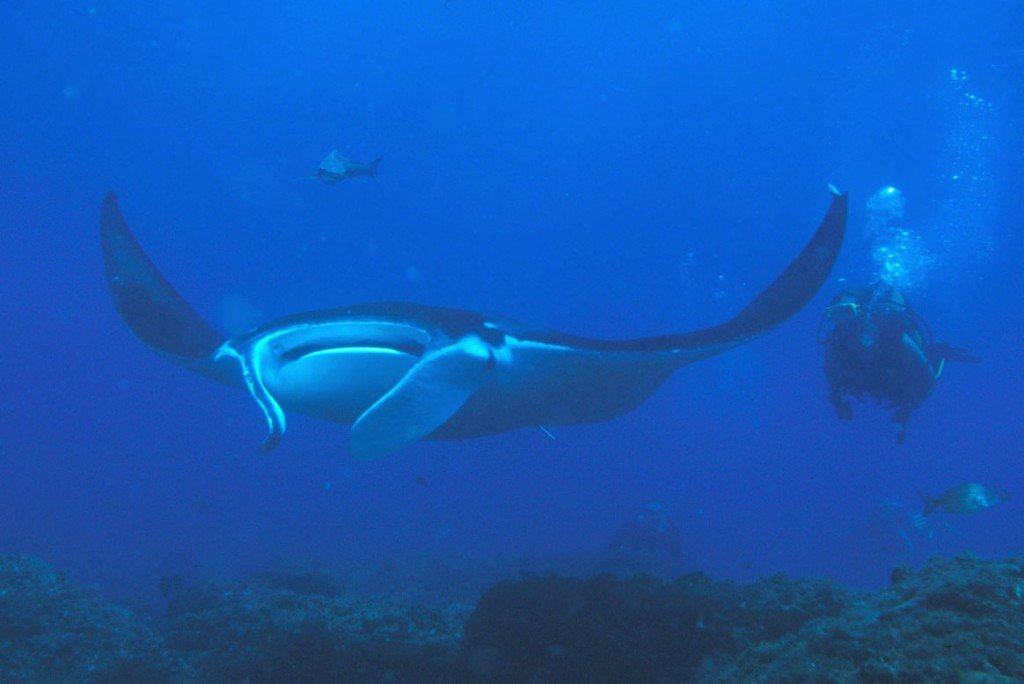
Manta Bowl is the spot for manta ray sightings in the Philippines. This flat underwater area of about 8 hectares that contains 5 different dive sites. The entire bowl is a feeding and cleaning station for manta rays, so when you dive here you will witness them feeding, playing, and roaming free. The area’s plankton-rich waters and playful currents also give you an excellent chance to catch sight of whale sharks, hammerhead sharks, and tiger sharks – not to mention gorgeous corals and all sorts of fascinating macro creatures.
Manta Bowl is a challenging dive site. It’s necessary to dive with a Dive Master here because of the drift, strong currents, and swirling eddies. You need to descend swiftly to avoid the current and stay close to your group at all times. Your Dive Master will help you to find a manta ray cleaning station and hook in. Next, sit back and enjoy the view of the majestic manta rays sweeping by while busy cleaner fish attend to them. You’ll also see schools of tuna, trevallies, and possibly even some sharks off in the blue.
The rays in Manta Bowl aren’t just plentiful, they’re also the biggest in the world! Manta Birostris rays can grow up to 9m. Witnessing these animals in this habitat is truly unforgettable. The manta ray is known to be the most harmless of all the ray species, because it only has a short tail (unlike the sting ray’s dangerous, stinging spine). Diving with manta rays is a great experience because these curious animals will normally get close to scuba divers, but never become hostile. They are believed to be quite intelligent. Don’t take our word for it, though – dive here yourself!
Dive Site #4: Panglao Island, Bohol
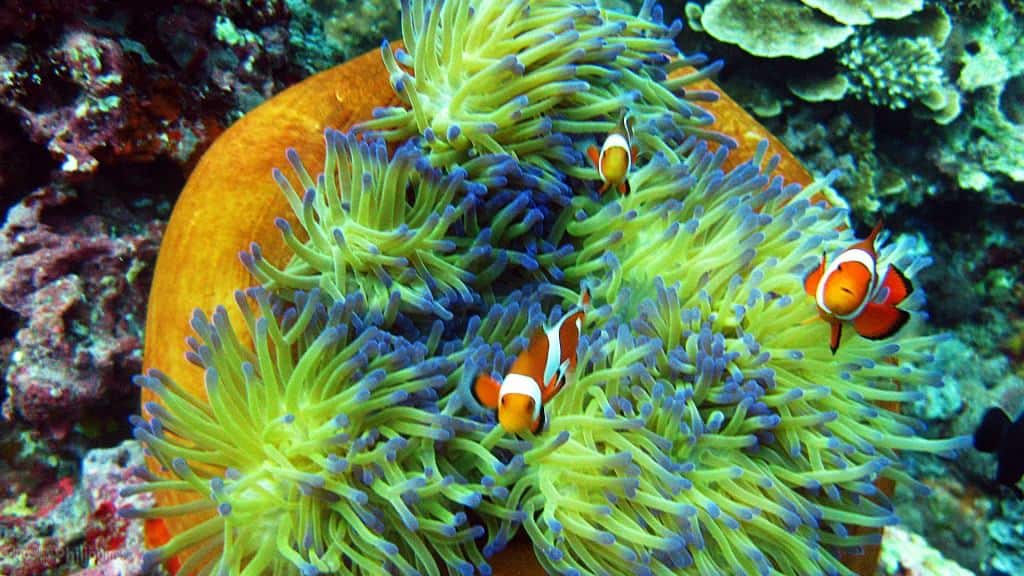
Panglao Island, located in the North Bohol Sea, is one of the most popular scuba diving destinations in the Philippines. The island is a limestone expanse of caves, sinkholes, plains, hills, and mountains. The exterior white sand beaches give way to crystal clear waters. The island is often likened to Boracay because of its wide array of adventures for tourists, like island-hopping, kite-surfing, fishing, dolphin-watching, snorkeling, and, of course, scuba diving!
Panglao features immensely rich biodiversity. The island is host to 2500 new species of mollusks and 250 new species of crustaceans, as well as countless fish and sea creatures. Here are some of the best dive sites around Panglao:
- Balicasag Island: the island’s most popular dive site, where you will be stunned by amazing narrow reefs, protected waters, and steep slopes covered in magnificent corals. Enjoy the wide assortment of barracudas, bannerfish, butterflyfish, nudibranches, batfish, and flatworms.
- Pamilacan Island: far from the main island but worth the travel for its spectacular visibility and its excess of manta rays, barracudas, bumphead parrotfish, and humphead wrasses. Whales and dolphins are often spotted here, too!
- Cervera Shoal: also known as “Snake Island” for the astonishing colonies of giant black-and-white banded sea snakes found 30m down. You’ll also see spectacular moray eels, nudibranches, and sea urchins while you’re diving here.
- Doljo Point: an excellent wall diving destination that offers up amazing displays of pipefish, nudibranches, gobies, clownfish, and cardinal fish.
Above the surface, Panglao Island Nature Resort & Spa features first-rate amenities for divers looking to rest their muscles and reminisce about their amazing wildlife sightings. A range of other accommodations, as well as activities ranging from island-hopping to kite surfing, also await you here. It’s easy to see why so many scuba divers choose Panglao Island for diving in the Philippines!
Dive Site #5: Mactan, Cebu

They say that Mactan is one of the “best kept secret diving destinations in the Philippines,” but we’re here to let you in on the secret. Mactan Island is a small, densely populated island located several kilometres off Cebu Island. It’s also known as “Coral Island”, and the incredible marine diversity in the surrounding waters lends itself to a variety of tourist attractions, like island hopping, snorkeling, and of course – scuba diving!
There’s an incredible array of diving found around Mactan Island. Scuba divers will relish the wide range of diving experiences, like caves, plateaus, wrecks, deep walls, coral mounts, and drop-offs. Here are some of the best dive spots in the area:
- Talima Sanctuary: the small shipwreck found here creates a sanctuary for an astonishing number of fish and shrimp. Enjoy sightings of parrotfish, butterflyfish, triggerfish, and sweetlips.
- West Punta: this area’s excellent visibility is a joy for underwater macro photographers. Octopuses, scorpionfish, flounders, nudibranches, and much more will drift into plain sight and perfect focus.
- Agus Wall: home to an amazing line-up of tropical fish and a diverse range of sponge species and corals. Follow the wall to discover sea anemones, clownfish, manta rays, and the occasional whale shark.
- Marigondon: a cave site for advanced divers. To reach it, you will descend 30m and venture into the cave (flashlight required). Inside the mouth of the cave you will be greeted by lionfish, big mouth mackarel, and other marine life that glows in the beam of your flashlight. When you exit, a paradise of coral is waiting for you.
Who would have guessed that one of the finest marine sanctuaries on Earth, Mactan Island, is located just 20 minutes from an international airport? Beginners and advanced divers alike will want to take advantage of this dive spot. Cebu has several top-rate PADI dive centres where you can take a certification course to fully experience what Mactan has to offer.
Dive Site #6: Puerto Galera, Mindoro
No one can deny that Puerto Galera is one of the most beautiful beach and scuba diving destinations in the Philippines. Its gorgeous seascapes and lush mountains make it a popular vacation spot for Filipinos and foreigners alike. The area’s famous, rustic beauty attracts visitors all year round. The terrain ranges from powdery white shores to beaches of dark and grainy sand. Puerto Galera is known for its wide range of activities: swimming, sailing, camping, hiking, rock-climbing, star-gazing, beach-hopping, wind-surfing, gold, kayaking, partying — and of course, scuba diving!
Scuba diving in Puerto Galera is a breeze. No need to hop on a boat to get to a dive site: a remarkable underwater world is waiting for you just 1 kilometre off the coast. As you wade out from shore, you will be bombarded by diverse marine life! The Verde Island Passage, where Puerto Galera is situated, is known to scientists as a biodiversity hot spot and to scuba lovers as a diving paradise. Amazing sea creates like damselfish, hawkbill turtles, flatwork Sharks, and flamboyant cuttlefish are all waiting for you and your camera to capture that coveted macro shot!
Puerto Galera is just 3 to 4 hours away from Manila by land and sea. The destination has many dive sites to choose from (some popular ones are Canyons, Monkey Beach, the Boulders, Dalaruan, Sinandigan, West Escarceo, Coral Garden, and Sabang). As a premiere diving destination, Puerto Galera has many dive resorts ready to offer you personalized services, a safe experience, and value for your money. Any diving experience you’re seeking can be found here: wildlife sightings, night diving, even a shipwrecked Japanese patrol boat from World War II.
Dive Site #7: Verde Island, off Batangas

Verde Island is located between Luzon and Mindoro islands, about an hour away from Puerto Galera. Divers from around the world are drawn to this island’s reefs for their excellent biodiversity and their astounding visibility. The warm and pristine waters of Verde Island offer over 30m of visibility on average. The island also has over 300 species of corals, which puts it on the map as the greatest concentration of coral species in the Philippines – and maybe even the world!
In the year 2006, Verde Island Passage was declared “Center of the Center of Marine Shorefish Biodiversity.” It is home to many threatened species, including giant groupers, humphead wrasses, the rare red fin wrasse, and giant clams. If you prefer wrecks to wildlife, you can visit the southern part of the passage to explore the wreckage of a Spanish galleon from 1620.
The most famous dive spot around Verde Island is The Pinnacle, a wall that drops off to a huge reef on the eastern side of the island. The column-shaped site goes down 60m. The narrow section nearest the surface is home to thousands of neon-colored anthias. As you explore deeper you will find even more sea creatures, like frogfish, bannerfish, jacks, basslets, pygmy seahorses, whip coral shrimp, spanish dancers, and – if you’re lucky – sea snakes.
Another famous destination for scuba divers near Verde Island is The Washing Machine. This adventurous spot is perfect for adrenaline junkies. Strong currents flow through intersecting canyons in a circular motion, like the spin cycle of a washing machine, whipping you in all directions. It is recommended that you wear gloves as you may need them to grab onto something while you’re being thrown about. Experiencing this phenomenon from the inside is a thrill!
Dive Site #8: Anilao, Batangas
Diving down into Anilao’s kaleidoscope of sea creatures feels like stepping into a Disney movie. You’re surrounding by every colour of the rainbow and fish of every size and shape imaginable. That’s because Anilao’s coastline has one of the highest concentrations of diverse marine life on Earth. Located in the Mabini area of Batangas, Anilao is treasured by divers and snorkelers for its ultra-rich marine life and shockingly expansive coral formations. Here in Anilao you will find 90% of the whole world’s species of coral.
If you’re looking to shoot some fabulous underwater macro images (or at least, score a sweet new Instagram post), Anilao is teeming with possibilities. The seascape features orange anthias, pygmy seahorses, shrimp, technicoloured nudibranches, damselfish, moray eels, and red-tooth triggerfish. Dive at night to encounter the blue-ringed octopus, sea goblins, catfish eels, and ghost popefish. To get started, arrange a trip to one of the area’s many popular dive sites. Cathedral Rock, Twin Rocks, Mainit Point, Sombrero Island, Maricaban Island, Bonito Island, Sepok Wall, and Beatrice Rock are all good bets.
Scuba diving in Anilao is an easy and enjoyable experience from start to finish. This underwater paradise is just a 2-hour drive from Manila. The area has around 30 excellent dive resorts that cater to both newbies and veteran divers. Experienced Dive Masters will provide for your every need and adapt your experience based on your level. Diving conditions are awesome year round: the surface is always tranquil, visibility is superb (18m on average), and the water is consistently warm (26-28°C in the summer and 22-26°C in the winter). What are you waiting for?
Dive Site #9: Tubbataha Reefs, off Palawan
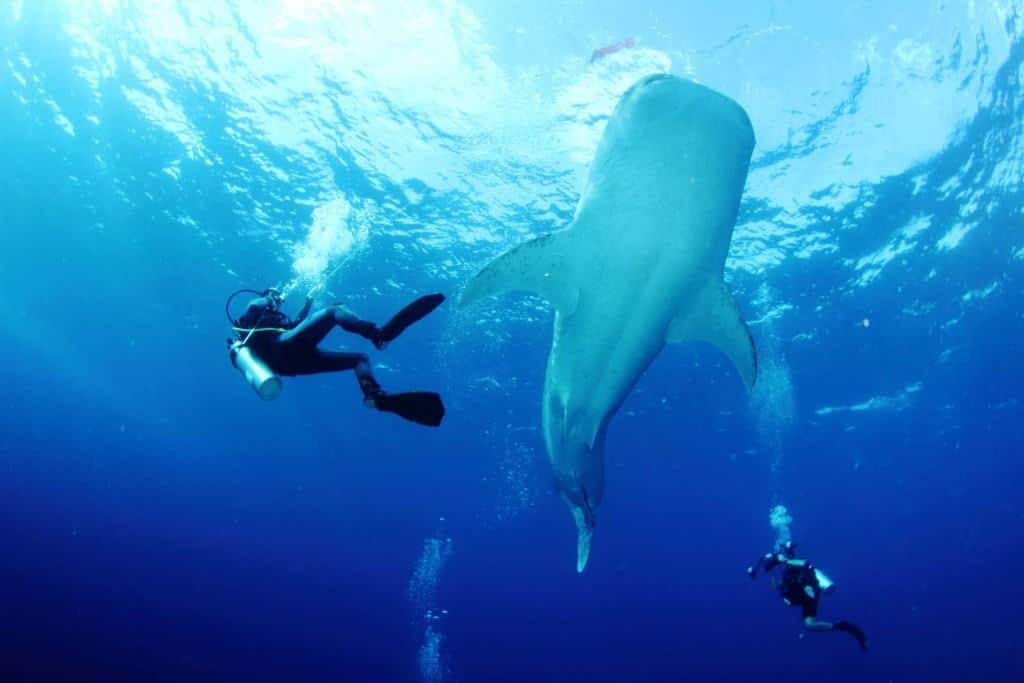
‘Tubbutaha’ is a blend of 2 words in the local language that means “a long reef exposed at low tide.” That’s actually a bit of an understatement for this incredible natural phenomenon. Tubbutaha Reefs Natural Park covers 97,030 hectares and contains massive atolls, extinct underwater volcanoes, and the Cagayan Ridge. It is found 150 km southeast of Puerto Princesa, the capital of Palawan, in the Sulu Sea. The park is a UNESCO World Heritage Site, a “Wetland of International Importance” according to the Ramsar Convention, and a nominee for the 2008 ‘New 7 Wonders Nature’ list.
Tabbutaha Reef is separated from Puerto Princesa by a 12 hour boat ride. The islets have no permanent residences, so your only option as a tourist is to visit with a live-aboard vessel. Plenty of companies offer multi-day outings on these boats. The package will include land transfers, accommodations, and all your dives. The reef is so renowned, though, that it’s almost impossible to book a last-minute trip during peak diving season (or “Tubbutaha season” as it’s known around here). Spaces on diving ships sell out well in advance for the period between March and June, when skies are calmest and seas are clearest.
Tubbutaha was discovered as a scuba diving destination in the 1970s and news of its startling coral and mind-blowing marine biodiversity rapidly spread around the world. More than 360 coral species cover two thirds of the park in pristine displays of reefs, walls, vast lagoons, and even 2 coral islands. These formations are home to an incredible array of wildlife. The area is a nesting ground for hawksbill and green sea turtles and it draws in many types of whales, sharks, dolphins, and of course – fish. Uniquely, this dive site is also a bird sanctuary. Many seabirds nest on a lighthouse islet in the southern atoll, giving you something to observe above water as well.
Tubbutaha is truly the dive of a lifetime. All scuba divers will be mesmerized by this experience, but if you’re a casual diver we would recommend picking up some training for more advance diving (Nitrox and drift diving especially) in order to get the most out of this diver’s paradise.
Dive Site #10: Wreck Dives off Coron, Palawan
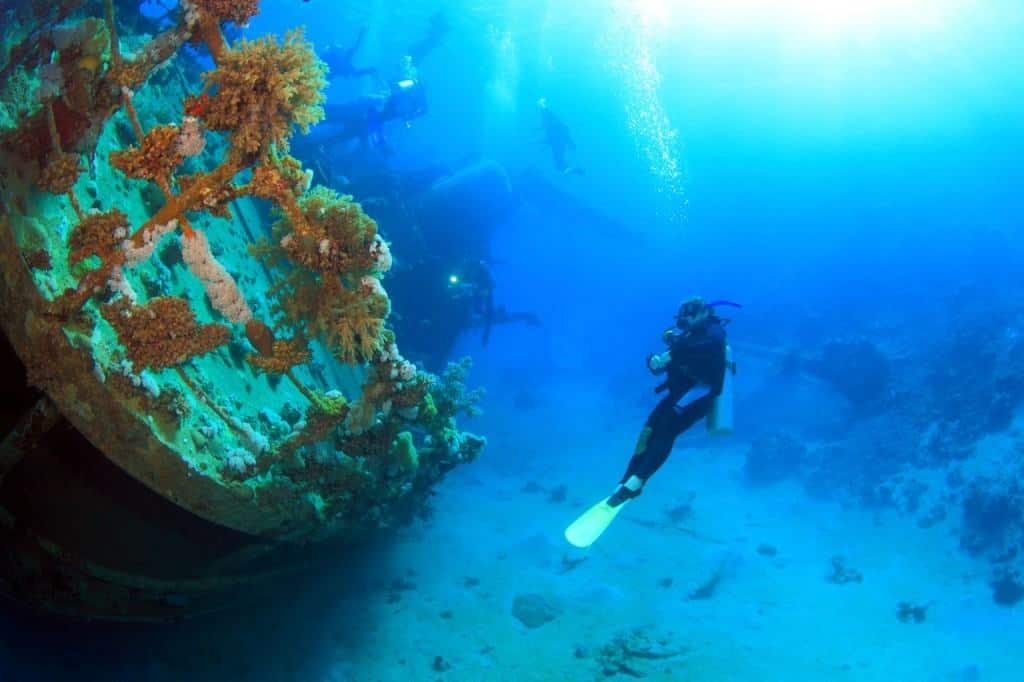
Coron is the largest town on the island of Busuanga in the province of Palawan. It’s one of the world’s most famous and coveted vacation spots because of its gorgeous beaches surrounded by limestone cliffs and inhabited by amazing wildlife. Its wonders extend below the sea, too.
Coron is one of the top scuba diving sites on the planet. It is especially famous for its World War II shipwrecks. There are 14 well-preserved underwater shipwrecks in the Coron Bay. All of them are Japanese ships that sank in September 1944 during a bold raid by the US Navy. The infamous wrecks are scattered throughout the bay. Novice divers can find wrecks 5m deep, and more advanced divers can explore wrecks down further than 40m. Each wrecked ship is between 100m and 200m long.
Here are some of the most enticing wrecks waiting for you in Coron:
- Irako is Coron’s most famous wreck because it is almost entirely intact. This 147m refrigerator shop, weighing in at 9723 tons, is an astonishing sight. It’s located at the mouth of Coron Bay, an area with excellent visibility. The ship’s deck sits at 35m and the wreck continues down to 43m. It’s possible for experienced divers to explore Irako’s engine room. At any level, Irako provides an amazing array of marine wildlife. Schools of tuna, scorpionfish, big groupers, and lionfish are permanent residents. Sea turtles have also been spotted nesting among the wreckage, and a 2m-wide stingray is known to hang out around the mast and display itself to divers from time to time.
- Okikawa Maru is the largest wreck in Coron Bay. This 168m-long Japanese tanker is covered in exquisite corals and shelters a delightful mix of marine life, like snappers, groupers, and batfish. The deck is 10m-16m deep, which is perfect for beginner divers. Advanced divers can enter the wreck through the propeller shaft and explore all the way through to the engine room.
- There’s another, unnamed Japanese freighter in the bay that scuba divers flock to. This imposing 137m wreck lies on its starboard side, and its port side is decorated with hard corals. Inside, schools of fish, turtles, and sea snakes abound, but the main event is the spacious cargo and engine room area. If you dive here when the sun is high (between 10am and 2pm), you will catch beams of sunlight filtering through the waters and seeping into every hole in the port-side wall. The cargo hold is bathed in warm, yellow light, creating a cathedral-like environment deep below the sea. Damage from the American bombing is preserved and illuminated in this unique environment, so that can swim through a piece of history frozen in time.
The best time to wreck-dive in Coron is during high tide or a quarter moon, otherwise the visibility may be challenging. Nitrox diving is advised for most wreck diving in order to increase your bottom time.
If you still need a little convincing, here’s a video of what’s waiting for you in the Philippines! This was shot off of Apo Island, #1 on our list of the best scuba diving sites in the Philippines:
Helpful articles and blog posts on scuba diving at the Philippines’ famous dive spots:
We only recommend writers and blogs that we read regularly and believe will deliver substantial value to our readers. The following are our top picks of articles and blogs that we think are worth reading for you to get more information and a more extensive guide to the most beautiful diving spots in the Philippines. These detailed accounts of some of the dive sites mentioned are sure to give you some helpful ideas, whether your next dive is your 1st or your 100th.
- “Your Guide to The Best Wrecks and Reefs of Coron Palawan” – by bookyourdive.com
- “The Great Apo Island Freediving Adventure”– by The Travelling Feet
- “Diving in Anilao, Batangas of the Philippines: A first-timer’s guide” – by Aileen Adalid of I Am Aileen
- “Dive Malapascua” – by Wanderlass
- “Tubbataha Reef, Palawan, my logged dives #949-962 – March 29-April 1, 2010” – by Vance Stevens of Vance’s Dive Blogs
- “Verde Island: The best Diving in Puerto Galera!” – by Scandidivers
How did we do?
Is the article “Top 10 Scuba Diving Sites in The Philippines” useful? If so, please share and like this post, as it helps other travelers find information. Many thanks! You can follow us on Twitter or Facebook for further updates!


